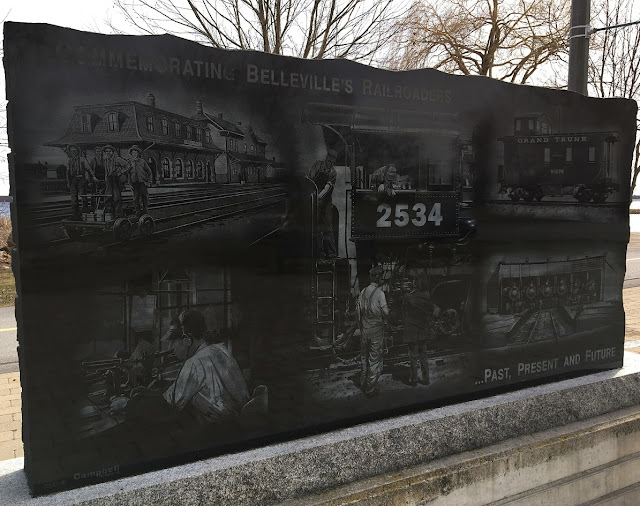The House That James Built
 |
| The Riverboat House on Bridge St.West Belleville |
The strident sound of the fire alarm tore through the quiet night sending those inside a local hotel scrambling outside.
It turned out to be a false alarm but even as relief washed over those present, the incident turned deadly for one man, a prominent citizen of Belleville. While attempting to run outside, he fell victim to a protruding bayonet and succumbed to his wound hours later.
The following morning -- Dec. 20, 1837 -- brought news of the fire and the consequent fatal accident sustained by James McNabb.
Elected to the assembly the year before, he was captain of the First Hastings, a local militia that was assembling in Belleville during the Mackenzie Rebellion of 1837.
The report in The Chronicle and Gazette Dec. 20 1837, quoted by the late Betsy Dewar Boyce in her book, "The Rebels of Hastings," read, "We regret to hear that J. McNabb, Esquire, of Belleville, has suddenly met his death in the most heart rending manner.
"An alarm of fire being given, Mr. McNabb was hurrying through the dark passage of an Inn, where a number of the armed militia were quartered, when he ran upon the fixed bayonet of one of the men, which pierced his abdomen. He died within 24 hours."
McNabb was buried at St. Thomas cemetery leaving behind his wife, Hannah Clark, alone in the grand house he had built for her just four years earlier. The house still stands today at 43 Bridge St. W. and because of its elaborate exterior trimmings, reminiscent of a riverboat, was nicknamed the "Riverboat House".
McNabb's house was originally built without its fancy trim. It was constructed in the British Regency style in cut stone. The large 12-paned windows allowed plenty of light.
Originally, historical sketches written of the house indicated that it had been constructed with a centre hall plan with its main entrance upstairs, opening off the veranda.
The house, a grand structure meant to provide the most comfort and status to its wealthy owner, was built at the time when Belleville's population stood at 1,200.
According to the book "Belleville, The Seat of Hastings County" authored by Nick and Helma Mika, the village of Belleville had no sidewalks, no drains or ditches to carry off water back then.
"In consequence, streets after a heavy rain were all but impassable. Garbage lay scattered for days in the streets and pedestrians making their way past the rubbish not only were apt to encounter a nauseating stench but more often than not, a pack of pigs scrounging through the refuse. The pigs which in those days freely roamed Belleville's streets were considered a perpetual nuisance, but in fact they represented the settlement's one and only "sanitation department". "
Street lighting consisted of lanterns to help night-time travellers.
Since the late 1820s, this community was regarded as an important one between Kingston and York.
Early arrivals described it as a place where jobs and business opportunities were plentiful, wrote the Mikas.
The flourishing community attracted potential settlers from far and near.
McNabb's own background showed a grandfather, a Loyalist surgeon from Vermont, by the name of Dr. James McNabb. The latter's two sons, James Jr. and Simon, came to settle with prominent jobs in Belleville.
While Simon McNabb was appointed registrar post master in Bellevile in 1816, James Jr. became the first collector of customs, local representative of the board of education for the Midland district and was elected a member of the Legislative Assembly of Upper Canada for Hastings and Ameliasburgh in 1816.
In 1804, Dr. McNabb bought some 200 acres west of the river along where the house is located today and operated on it a grist mill, a saw mill, a distillery and blacksmith shop. A large residential house was also built on the property.
He sold the property to the Hunter brothers and in 1814, a man named Thomas Coleman bought the majority of the property except for 20 acres near the harbour. The remaining land was bought by Dr. Seth Meacham in the same year.
Dr. McNabb died in 1820 and his son, James Jr., who became captain of the First Hastings Militia bought back some property from the Meachams and built his home at what is today known as 43 Bridge St. W.
In 1859, a local lawyer named Horace Yeomans bought the house and dressed it up with trim and triellage. He also added the dormers and the elaborate veranda that individually surrounds the two floors. The house stayed in the Yeomans family for years.
Ownership changed through the years and by 1940, when it was owned by the Ming family, who lived in the United States, converting the house into apartments.
Local historian Lois Foster recalled finding the house in shambles before it was bought by Brian Magee and restored some years ago.
"He bought it and restored it to perfection. It needed an awful lot of work. I went to see it before anything was done. You could jump on the floor on the main floor and nothing jiggled. It was so solid."
Careful restoration later the house still stands today, a memento of the love once borne by a prominent member of this community for his young wife.



Comments
Post a Comment